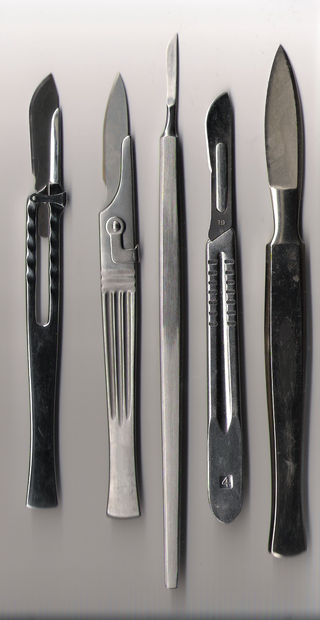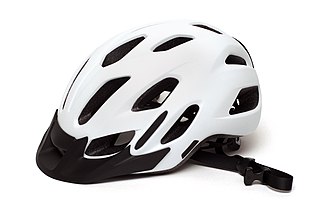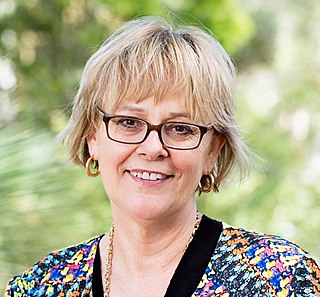
The Centers for Disease Control and Prevention (CDC) is the national public health agency of the United States. It is a United States federal agency under the Department of Health and Human Services, and is headquartered in Atlanta, Georgia.

A scalpel, lancet, or bistoury is a small and extremely sharp bladed instrument used for surgery, anatomical dissection, podiatry and various arts and crafts. Scalpels may be single-use disposable or re-usable. Re-usable scalpels can have permanently attached blades that can be sharpened or, more commonly, removable single-use blades. Disposable scalpels usually have a plastic handle with an extensible blade and are used once, then the entire instrument is discarded. Scalpel blades are usually individually packed in sterile pouches but are also offered non-sterile. Double-edged scalpels are referred to as "lancets".

An occupational injury is bodily damage resulting from working. The most common organs involved are the spine, hands, the head, lungs, eyes, skeleton, and skin. Occupational injuries can result from exposure to occupational hazards, such as temperature, noise, insect or animal bites, blood-borne pathogens, aerosols, hazardous chemicals, radiation, and occupational burnout.

A bicycle helmet is a type of helmet designed to attenuate impacts to the head of a cyclist in collisions while minimizing side effects such as interference with peripheral vision.

Safety in numbers is the hypothesis that, by being part of a large physical group or mass, an individual is less likely to be the victim of a mishap, accident, attack, or other bad event. Some related theories also argue that mass behaviour can reduce accident risks, such as in traffic safety – in this case, the safety effect creates an actual reduction of danger, rather than just a redistribution over a larger group.

Travel medicine or emporiatrics is the branch of medicine that deals with the prevention and management of health problems of international travelers.

A ski helmet is a helmet specifically designed and constructed for winter sports. Use was rare until about 2000, but by about 2010 the great majority of skiers and snowboarders in the US and Europe wear helmets. Helmets are available in many styles, and typically consist of a hard plastic/resin shell with inner padding. Modern ski helmets may include many additional features such as vents, earmuffs, headphones, goggle mounts, and camera mounts.
Injury prevention is an effort to prevent or reduce the severity of bodily injuries caused by external mechanisms, such as accidents, before they occur. Injury prevention is a component of safety and public health, and its goal is to improve the health of the population by preventing injuries and hence improving quality of life. Among laypersons, the term "accidental injury" is often used. However, "accidental" implies the causes of injuries are random in nature. Researchers prefer the term "unintentional injury" to refer to injuries that are nonvolitional but often preventable. Data from the U.S. Centers for Disease Control show that unintentional injuries are a significant public health concern: they are by far the leading cause of death from ages 1 through 44. During these years, unintentional injuries account for more deaths than the next three leading causes of death combined. Unintentional injuries also account for the top ten sources of nonfatal emergency room visits for persons up to age 9 and nine of the top ten sources of nonfatal emergency room visits for persons over the age of 9.

A rollover protection structure or rollover protection system (ROPS) is a system or structure intended to protect equipment operators and motorists from injuries caused by vehicle overturns or rollovers. Like rollcages and rollbars in cars and trucks, cabs, frames or rollbars on agricultural and construction equipments, a ROPS involves mechanical components attached to the frame of the vehicle that maintain a clearance zone large enough to protect the operator's body in the event of rollover.
SafetyLit is a bibliographic database and online update of recently published scholarly research of relevance to those interested in the broad field of injury prevention and safety promotion. Initiated in 1995, SafetyLit is a project of the SafetyLit Foundation in cooperation with the San Diego State University College of Health & Human Services and the World Health Organization - Department of Violence and Injury Prevention.
Occupational Medicine is a peer-reviewed medical journal covering occupational medicine. It is published eight times per year by Oxford University Press. The journal covers "work-related injury and illness, accident and illness prevention, health promotion, occupational disease, health education, the establishment and implementation of health and safety standards, monitoring of the work environment, and the management of recognized hazards". It was established in 1948.
An occupational fatality is a death that occurs while a person is at work or performing work related tasks. Occupational fatalities are also commonly called "occupational deaths" or "work-related deaths/fatalities" and can occur in any industry or occupation.

The Chinese Center for Disease Control and Prevention is an institution directly under the National Health Commission, based in Changping District, Beijing, China.
Leif Svanström, 1943-2023, was a Swedish doctor and a specialist in Social medicine.
The International Journal of Injury Control and Safety Promotion is a peer-reviewed scientific journal covering research in ergonomics, product safety, and the prevention and care of injuries. It is published by Taylor & Francis and is an official journal of the European Association for Injury Prevention and Safety Promotion (EuroSafe), formerly the European Consumer Safety Association (ECOSA). JCR: According to the Journal Citation Reports, the journal has a 2016 impact factor of 0.875.

Occupational safety and health (OSH), also commonly referred to as occupational health and safety (OHS), occupational health, or occupational safety, is a multidisciplinary field concerned with the safety, health, and welfare of people at work. These terms also refer to the goals of this field, so their use in the sense of this article was originally an abbreviation of occupational safety and health program/department etc.

The Federal Medical-Biological Agency or FMBA is the national public health institute of the Russian Federation. The agency is a federal agency under the Ministry of Health and is headquartered in Volokolamsk Highway, in Moscow.

Dinesh Mohan was honorary professor at Indian Institute of Technology Delhi since 2017. He was distinguished professor at Shiv Nadar University, Gautam Buddha Nagar (India) from 2016 to 2018. From 2010 to 2015 he was Emeritus Volvo Chair Professor for Transportation Planning & Safety at IITD. He was head of Centre for Biomedical Engineering (1991–1996), Coordinator of the Transportation Research and Injury Prevention Programme (1998–2010) and head, W.H.O. Collaborating Centre for Research and Training in Safety Technology at IIT Delhi (1991–2010). He was also Director, Independent Council for Road Safety International (www.icorsi.org).
David A. Sleet is an American scientist recognized for championing the application of behavioral science to unintentional injury prevention and helping to establish injury prevention as a global public health concern. He has published hundreds of articles and book chapters and was co-editor of the Handbook of Injury and Violence Prevention.; Injury and Violence Prevention: Behavioral Science Theories; Derryberry’s Educating for Health; and the international prize-winning World Report on Road Traffic Injury Prevention.

Caroline Finch AO is an Australian sports injury epidemiologist and sports injury prevention researcher. Her research has been adopted and used to directly inform safety policy by Government Departments of Sport and Health, health promotion and injury prevention agencies, and peak sports bodies both within Australia and internationally. Her injury prevention research has been applied to falls in older people, road safety, workplace safety and injuries in children.












